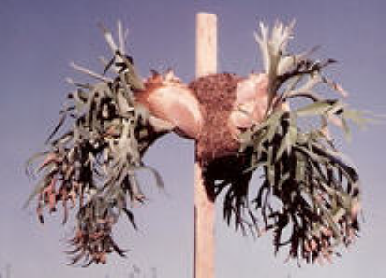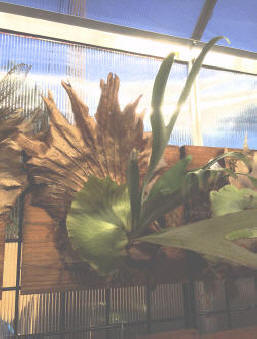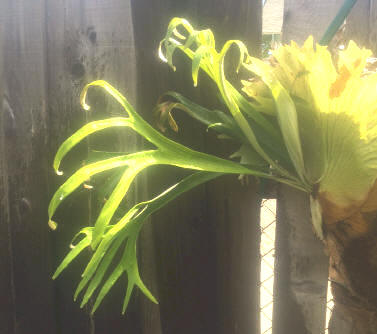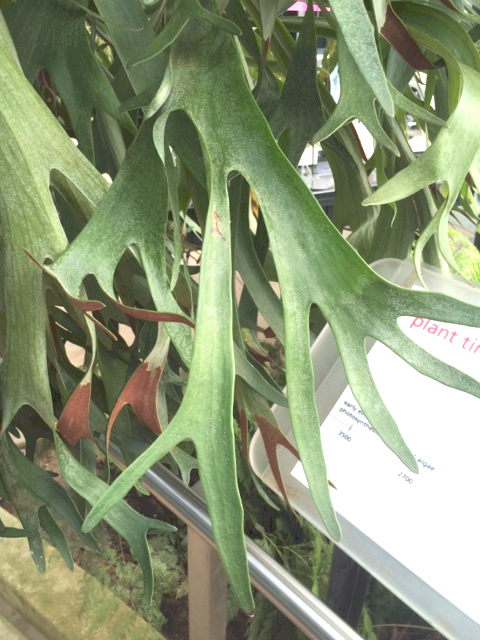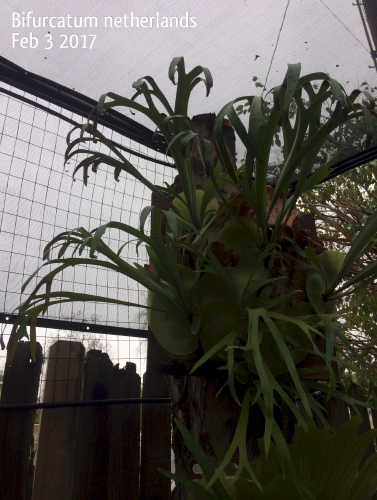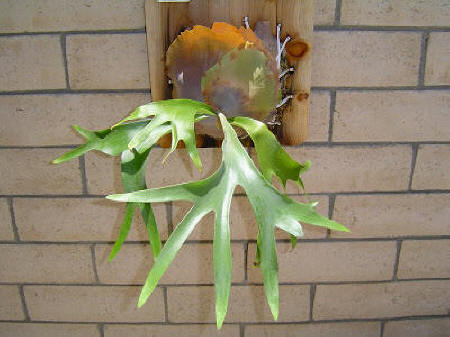|
|
||||||
|
The P. bifurcatum is probably the
most common platy in the world. That may be why is is called a
"Common Staghorn". The number of different cultivars within the
bifurcatum group is beyond the scope of this document. However
we will attempt to list the ones we know about. This web page is
not intended to be 100% accurate with the listing of bifurcatum
cultivars. Short of DNA testing, the room for error and
duplication is enormous. Someday soon we hope to have this DNA
tool to classify plants. Charles Alford on his web site, RareFerns.com suggests the existence of the P. bifurcatum complex which include P. bifurcatum, P. hillii, P. veitchii, and P. willinckii all under the P. bifurcatum complex. There is some good logic supporting this suggestion. Recent DNA findings confirm a close relation ship within the P. bifurcatum complex, however they are all recognized as different species. This species name comes from the word bifurcate which means to divide or fork. It describes the branching shape of the fertile fronds. Generally speaking, P. bifurcatum has narrow fertile fronds, upright with the tips frequently bending downward. There are distinctively prominent veins on the top of the fertile fronds. This chrematistic is also found on P. wallichii which is not part of the P. bifurdatum complex. The tips of the shield are divided into lobes which are often pointed and extend forward. The shields are usually tan to brown during the spring and summer. New green shields form during the late summer and fall. Fertile fronds remain green and form most of the year. Each fertile frond lives two to three years. Most of the platyceriums found within the bifurcatum complex provide volunteers or pups quite frequently. This probably accounts for the large numbers of them found in collections. You can find a P. bifurcatum, P. hillii, P. veitchii, and P. willinckii in any good collection, but finding P. quadridichotomum, P. wallichii, or other platyceriums is more difficult. It is difficult to find a good photo of the P. bifurcatum Netherlands on the net. What I find appears to be mislabeled by my understanding and the photos on Goggle don't do justice. This exemplifies the cause of the problem and the tendency to call anything a bifurcatum if you don't have a proper identification. In many cases it may be better to leave it unlabeled to prevent future confusion. Wendy Franks feels the P. bifurcatum can withstand temperatures near 25 degrees Fahrenheit for short periods of time. Can also be conditioned to take full sunlight most of the time as seen in the above photo. Wendy lists the following as cultivars of the bifurcatum species: Majus, Netherlands, Roberts, San Diego, and Ziesenhenne. Today the list is much longer and is included at the bottom of the photos. The season for remounting in the Northern hemisphere is December as new shields will start forming in January and cover the mounting media. |
||||||
|
These photos show what I personally call a Netherlands. The fertile fronds are upright, slender with the tips turned down on the ends. As the individual grows, more and more forked fingers will appear. The shield fronds are lobed on the ends and turn a golden brown when they die. The fern on the right is thriving in full sun which is another chrematistic of the P. bifurcatum cv Netherlands.
|
||||||
|
|
||||||
 Cultivar
Celebes Island (Walters) is from the island of Celebes in Indonesia.
Many of these are from the Tony Barrett collection and not easily
found. I put it in the bifurcatum species because the fronds are
vertical, narrow, and multi-forked as displayed in the left photo from
Rainforest Flora in Torrance. Cultivar
Celebes Island (Walters) is from the island of Celebes in Indonesia.
Many of these are from the Tony Barrett collection and not easily
found. I put it in the bifurcatum species because the fronds are
vertical, narrow, and multi-forked as displayed in the left photo from
Rainforest Flora in Torrance.
On the right is another Celebes cultivar from Tom Gauci collection in Huntingon Beach. The fronds are more like a P. hillii species, wide and less slender fingers. Go figure! This is where plant DNA testing is needed Neither plant has the tips of the fertile fronds turned down, so possibly they are not biforcatums. I don't understand how "Walters" figures in to the name. |
||||||
|
|
||||||
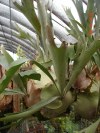
Cultivar Forgii from the Rainforest Flora collection, displays the narrow forked fertile fronds. The plant is too young to fully see its traits. Can't find any more information on the cultivar Forgii, but these forked fingers look uniquely narrow and long. The photo on the right is a forgii offered on eBay for $500. Click on image to see a larger image. |
||||||
|
|
||||||
|
Cultivar Gornto from the Rainforest Flora collection displays the narrow fronds of bifurcatums, but the length of the fingers is not consistently similar like bifurcatums. The shield frond does display the lobed tops of a bifurcatum. |
||||||
|
|
||||||
|
The cultivar Mickey's Rainbow has many of the chrematistics of bifurcatum. Narrow fronds getting wider at the forked ends. This plant does not appear to have vertical fronds, but that could be a result of its growing environment. The shield frond could be loped and it grows pups freely. |
||||||
|
|
||||||
  The cultivar Paul Webber pictured left is from Roy Vails collection. On the right is a photo from Siam Exotica Plants in Thiland of their P. Paul Webber and it does not look like a bifurcatum. There are other subjects called P. Paul Webber, but they have narrow fertile fronds and I don't see any evidence they are P. Paul Webber. |
||||||
|
|
||||||
 The cultivar Maui on left from the Rainforest Flora collection appears to be the same as the cultivar Hawaii in the Siam Exotica Plants web site pictured right. A strong candidate for being a biforcatum with the narrow vertical fronds with drooping tips. We don't have a good view of the shield frond. |
||||||
|
|
||||||
 The cultivar South Seas does not have similar photos between Rainforest Flora and Siam Exotica Plants. The Rainforest Flora photo on left looks like a biforcatum, but the Siam Exotica Plants photo looks more like a P. bifurcatum cv vildrii, or P. bloomei. |
||||||
|
|
||||||
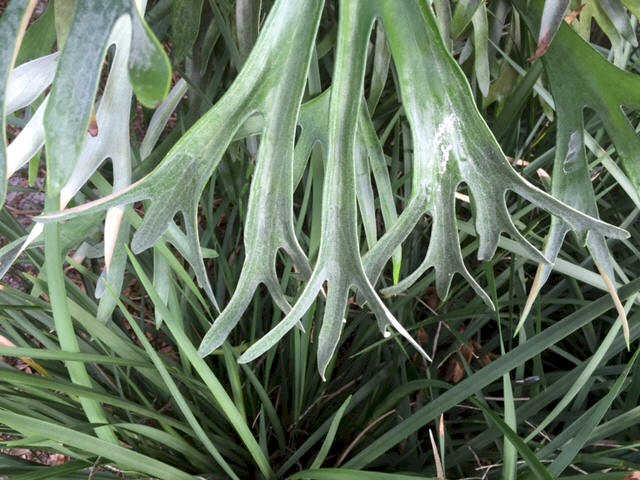
P. biforcatum 'Electrofolia' hybrid (P. bifurcatumm x P. veitchii) This photo was submitted by Denise in FL and she claims this platy has 18 to 24 fingers per fertile fronds. It is suspected the platy is quite old and well established enabling it time to grow multiple fingers. It is probably a hybrid and not a new species. From the dark color, it appears to be growing in the shade.
|
||||||
|
|
||||||
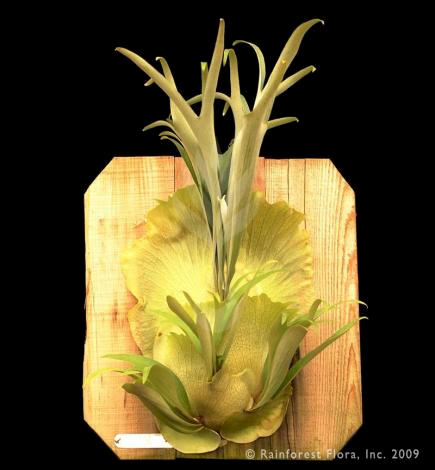
The Japanese Hybrid is one of the plants offered by Rainforest Flora in Hawthorne, CA. They don't mention the lineage, but say it "is one of the more popular stags." "With large shield fronds and tall, erect fertile fronds, it makes an elegant statement." We are placating it within in the bifurcatum species family assuming it is a cross between bifurcatum and something else.
Photo: Rainforest Flora |
||||||
|
|
||||||
|
P. bifurcatum 'South Seas' A new cultivar believed from Polynesia with very long fingers on the fertile fronds. Believed easy to grow, however one hobbyist feels his died because he did not keep the humidity high enough in his greenhouse. Where he lives it very hot and dry in the summer and it is difficult to keep the humidity high. Another hobbyist feels temps 40 to 90 degrees are best and he grows them outdoors, not far from the beach. Morning sun or filtered light is ideal. Typical bifurcatum needs. Steve Talnadge of Chula Vista, CA created this graceful fern with long and wide reclining fertile fronds with long fingers. Talnadge Nursery, introduced many new cultivars back in the 1970s and he used to sell a lot at the San Diego County Fair in Del Mar, CA. After further thought, I have concluded the P. south seas is not a unique species as originally classified, but a cultivar in the bifurcatum family. The shield fronds form baskets like bifurcatums. The fertile fronds are moderately broad, but not as wide as a P. hillii. Photo: Tom Gauci, Los Angeles International Fern Society |
||||||
|
|
||||||
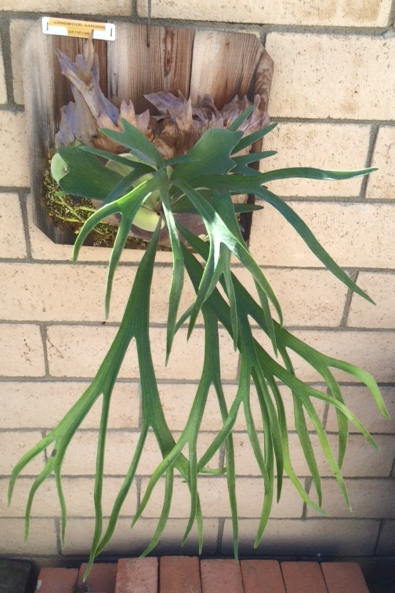 This
P. bifurcatum 'Longwood Gardens' is unique in its narrow fingerlike
fertile fronds. They are very long and very slender which is quite
different from most bifurcatums. This platy is from Tom Gauci's
collection in Huntington Beach. This
P. bifurcatum 'Longwood Gardens' is unique in its narrow fingerlike
fertile fronds. They are very long and very slender which is quite
different from most bifurcatums. This platy is from Tom Gauci's
collection in Huntington Beach.If you look close, you will see a new pup volunteering on the left side. Normally P. bifurcatum pups form in the lower moist region of the plant. When they form on the side, eventually they may form a ring around the host tree like P. elephantitis, P. willinckii, P. andinum, P. coronarium and P. quadridichotomum. |
||||||
|
|
||||||
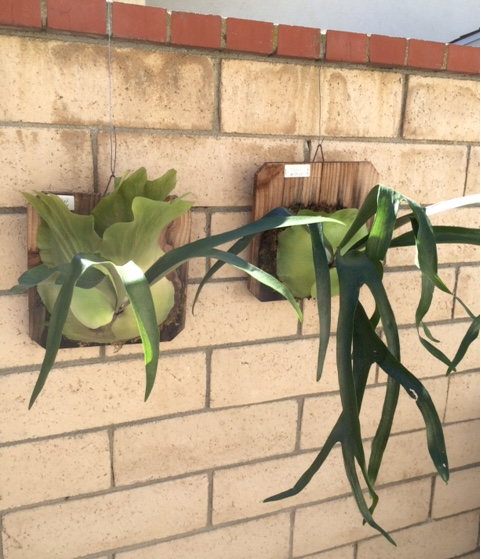
This picture is of two different P. kingii. The left is a regular P. platycerium kingii and the right is a P. platycerium kingii 'Sanchez'. Both are from Tom Gauci's collection in Huntington Beach. Besides the name, I am not sure of the difference. The 'Sanchez' appears to have longer fertile fronds, but that may be its age and or its environment. |
||||||
30 bifurcatum cultivars are listed below.
This does not mean there are only 30 cultivars, there may be more, or
there may be duplicates. It is suspected that as affordable
plant DNA testing comes available in the near future, we will find
many of these plants are the same plant with more than one name.
But until that battle is fought and won, we will stick with these
names and not upset any one. It should also be mentioned that
characteristics people feel make it a new cultivar, may just be a
result of its growing environment. Relocate these "cultivars" to
a different location, and they may lose these characteristic traits.
|
||||||
|
[
Plant Glossary ] |
||||||

